Bone Health Nutrition Calculator
Your Bone Health Nutrient Recommendations
Key Nutrients for Bone Health
Calcium
Essential for bone structure and strength.
Vitamin D
Helps absorb calcium and supports bone remodeling.
Magnesium
Activates vitamin D and supports bone crystal formation.
Vitamin K2
Directs calcium to bones and prevents calcification of arteries.
Quick Takeaways
- A bone‑healthy lifestyle blends nutrition, activity, hormones and regular monitoring.
- Calcium and vitaminD are essential, but they work best with protein, magnesium and vitaminK2.
- Weight‑bearing and resistance training trigger the body’s natural repair system.
- DXA scans give a clear picture of bone density and help track progress.
- Supplements and medications should be paired with lifestyle changes for safety and maximum benefit.
Bone loss isn’t just a medical issue that shows up on a scan; it’s a signal that several parts of your life are out of balance. When you treat the problem with a single pill or a one‑time exercise plan, you’ll often see only temporary gains. A holistic approach to bone loss means looking at diet, movement, hormones, and monitoring together, so each piece supports the others.
What Exactly Is Bone Loss?
Osteoporosis is a progressive condition where bone tissue becomes porous, making fractures more likely. It usually develops silently until a break occurs, but early signs include decreased bone mineral density (BMD) measured by a DXA scan. The body constantly remodels bone-breaking down old tissue and building new. When the breakdown phase outpaces formation, density drops and strength erodes.
Core Pillars of a Holistic Strategy
Think of bone health as a three‑legged stool: if any leg is weak, the whole thing wobbles. The pillars are nutrition, mechanical loading (exercise), and hormonal/metabolic balance, all overseen by regular medical assessment.
- Nutrition: Adequate calcium, vitaminD, protein, magnesium, and vitaminK2.
- Exercise: Weight‑bearing, resistance, and balance activities that stimulate bone formation.
- Hormonal health: Estrogen, testosterone, thyroid hormones, and vitaminD metabolism.
- Monitoring: DXA scans, FRAX risk scores, and lab panels to catch problems early.
Nutrition Deep Dive
Food is the foundation. The body can’t build bone without the right building blocks.
Calcium is the primary mineral that provides structural strength to bone tissue is essential, but it needs vitaminD to be absorbed effectively. The recommended intake for adults 50+ is 1,200mg per day, split across meals to improve absorption.
Vitamin D regulates calcium absorption in the gut and supports bone remodeling works best when serum levels stay between 30-50ng/mL. Sun exposure (10-15minutes a day) plus fortified foods or a 1,000-2,000IU supplement usually does the trick in most climates.
Protein supplies the collagen matrix that holds mineral crystals. Aim for 1.0-1.2g per kilogram of body weight daily, favoring lean meat, fish, dairy, legumes, and nuts.
Magnesium and vitaminK2 are often overlooked but they keep calcium in the right place. Magnesium helps activate vitaminD, while K2 directs calcium to bone rather than arteries. Foods like leafy greens, fermented soy, and nuts boost these nutrients.
| Nutrient | Recommended Daily Intake | Top Food Sources | Main Role in Bone Health |
|---|---|---|---|
| Calcium | 1,200mg | Milk, cheese, yogurt, fortified plant milks, sardines | Provides mineral framework for bone matrix |
| VitaminD | 800-2,000IU | Sunlight, salmon, fortified orange juice, eggs | Enhances intestinal calcium absorption |
| Magnesium | 320-420mg | Almonds, spinach, black beans, whole grains | Activates vitaminD, supports bone crystal formation |
| VitaminK2 | 90-120µg | Natto, hard cheese, egg yolk, butter | Guides calcium to bone, prevents arterial calcification |
| Protein | 0.8-1.2g/kg body weight | Chicken, fish, legumes, Greek yogurt, tofu | Forms collagen scaffold for mineral deposition |
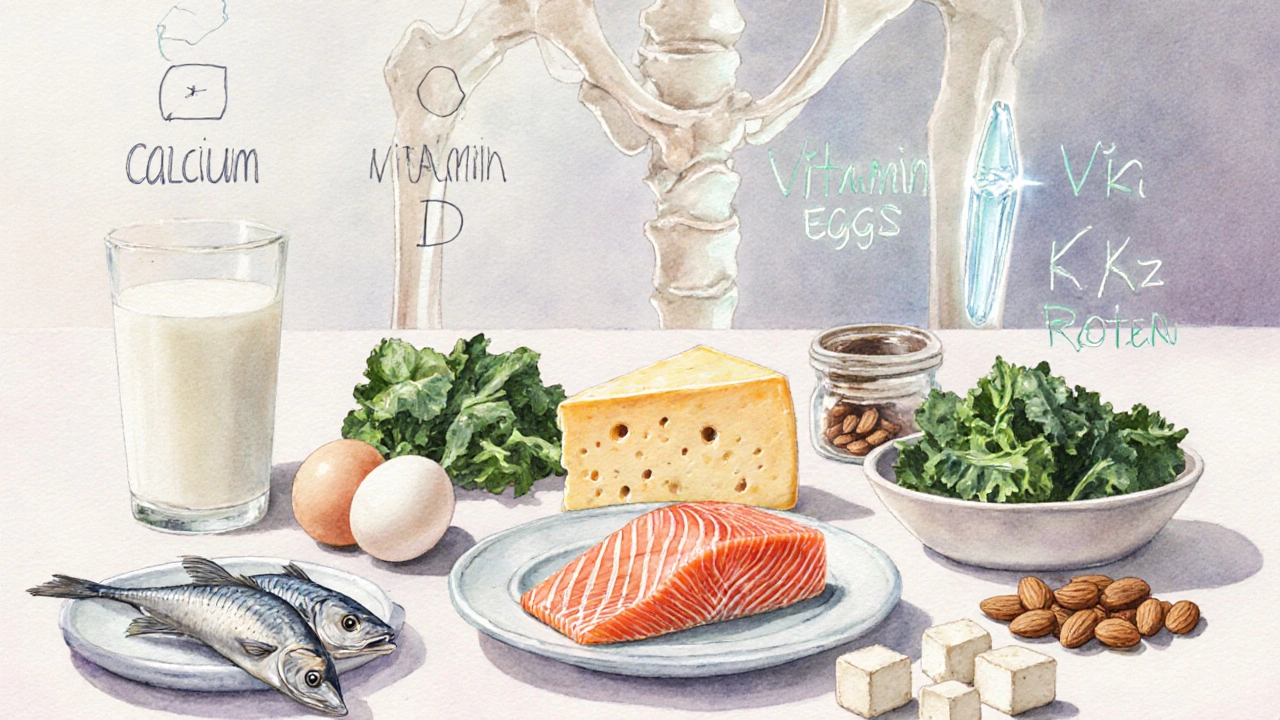
Exercise and Mechanical Loading
Bones respond to stress. When you lift, jump, or even walk briskly, tiny micro‑fractures form. The body repairs these micro‑fractures, making the bone denser and stronger-a process called mechanotransduction.
Weight‑bearing exercise includes activities where you support your own body weight, such as walking, jogging, or stair climbing is the most accessible way to stimulate bone. Aim for at least 150minutes of moderate aerobic activity weekly.
Resistance training adds a higher load, targeting the hips, spine, and forearms-common fracture sites. Using free weights, resistance bands, or body‑weight moves (squats, push‑ups, lunges) for 2-3 sessions a week can boost BMD by 1-2% per year.
Balance and flexibility drills (tai chi, yoga) reduce fall risk, complementing the strength gains.
Hormonal & Metabolic Balance
Hormones act as messengers that tell bone cells when to build or break down tissue. A drop in estrogen after menopause accelerates bone resorption, while low testosterone in men has a similar effect.
Estrogen protects bone by inhibiting osteoclast activity (the cells that break down bone) can be supported naturally through phyto‑estrogens (flaxseed, soy) and, when needed, low‑dose hormone therapy under medical supervision.
Thyroid over‑activity can increase bone turnover, so regular thyroid panels are advisable, especially if you have a history of hyperthyroidism.
VitaminD also functions as a hormone, influencing calcium regulation, immune response, and muscle function. Keeping serum levels in the optimal range helps maintain overall metabolic health.
Medical Assessment and Ongoing Monitoring
Even with perfect lifestyle habits, you need objective data to gauge risk and track improvement.
Dual‑energy X‑ray absorptiometry (DXA) is the gold‑standard imaging test that measures bone mineral density at the hip and spine is recommended at age50 for women and60 for men, or earlier if risk factors exist. Results are expressed as T‑scores:‑1.0 or above is normal,‑1.0 to‑2.5 indicates osteopenia, and‑2.5 or lower confirms osteoporosis.
The FRAX score calculates a 10‑year probability of major osteoporotic fracture using clinical risk factors and, optionally, BMD helps decide if medication is warranted.
Blood work checking calcium, vitaminD, parathyroid hormone, thyroid hormones, and bone turnover markers gives a fuller picture of what’s driving any loss.
Integrating Pharmacy & Supplementation Safely
When lifestyle alone isn’t enough, clinicians may prescribe anti‑resorptive drugs such as bisphosphonates. While effective, they can cause rare side effects like atypical femur fractures or jaw osteonecrosis.
Bisphosphonate medication that slows bone breakdown by inhibiting osteoclast activity should be taken exactly as directed-usually on an empty stomach, with a full glass of water, and staying upright for 30minutes.
Calcium supplements are helpful if dietary intake falls short, but they work best when paired with vitaminD and a balanced diet. Avoid high‑dose calcium alone, as it can increase cardiovascular risk.
Discuss any supplement regimen with your pharmacist or doctor, especially if you’re on blood thinners, thyroid meds, or diuretics, to prevent interactions.
Putting It All Together: A Personalized Bone‑Health Checklist
- Schedule a DXA scan and calculate your FRAX risk.
- Review blood work for calcium, vitaminD, PTH, and thyroid function.
- Ensure daily intake of 1,200mg calcium, 800-2,000IU vitaminD, 300-400mg magnesium, and 90-120µg vitaminK2.
- Plan at least 150minutes of weight‑bearing cardio plus 2-3 resistance sessions weekly.
- Incorporate balance work (tai chi, yoga) 2 times a week.
- Assess hormonal status; consider phyto‑estrogen foods or therapy if indicated.
- Talk to your doctor about whether a bisphosphonate or other medication fits your risk profile.
- Re‑scan every 1-2years to monitor changes and adjust the plan.
Following this checklist turns bone health from a reactive concern into a proactive lifestyle.
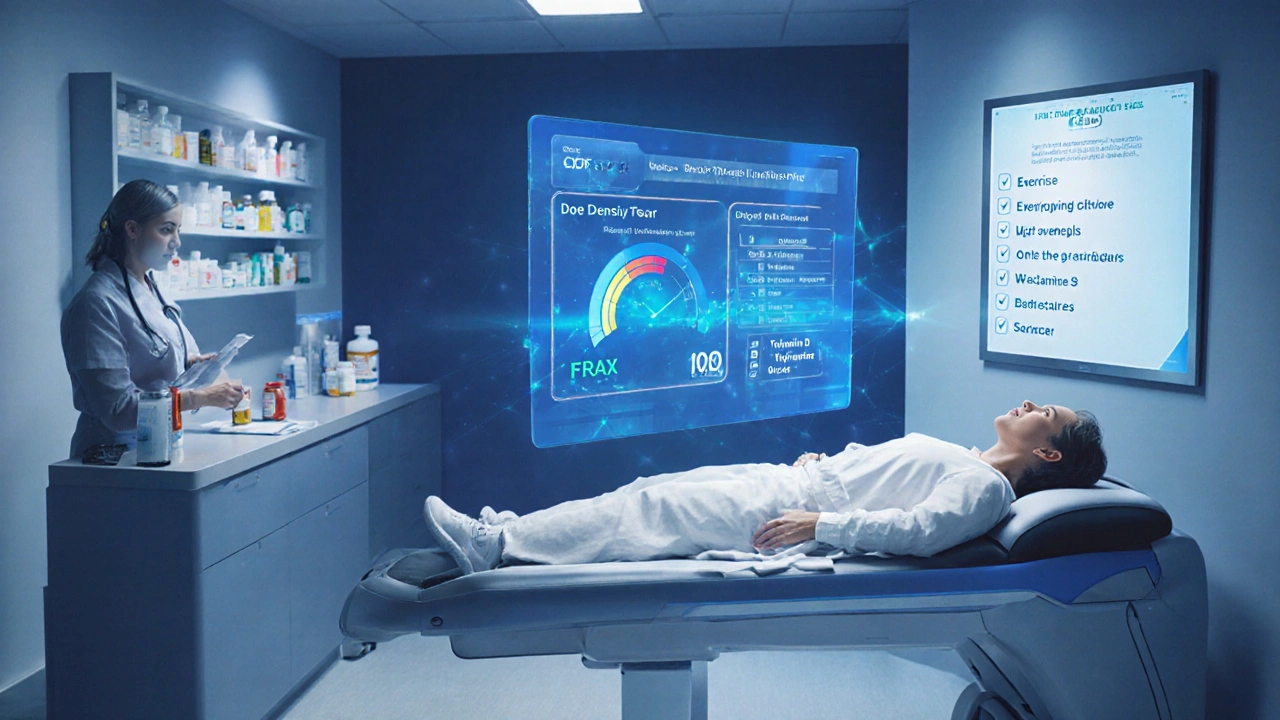
Frequently Asked Questions
Can I prevent osteoporosis without medication?
Yes, many people keep their bone density in the normal range by combining adequate nutrition, regular weight‑bearing exercise, and routine monitoring. Medication becomes necessary when the FRAX score or DXA T‑score crosses a treatment threshold.
How often should I get a DXA scan?
For most adults at average risk, a repeat scan every 1-2years is sufficient. If you start medication or have rapidly changing risk factors, your doctor may recommend annual testing.
Is calcium supplement enough if I’m already eating dairy?
Probably not. The body needs vitaminD to absorb calcium, plus magnesium and vitaminK2 to direct it to bone. Focus on a balanced diet first; supplement only to fill gaps identified by a nutritionist or lab test.
Can high‑impact sports hurt my bones?
High‑impact activities like jumping are great for stimulating bone, but they should be introduced gradually and paired with proper technique. Overtraining without recovery can increase fracture risk, especially in those with already low BMD.
What are the side effects of bisphosphonates?
Common issues include mild stomach upset and esophageal irritation. Rare but serious problems are atypical femur fractures and jaw osteonecrosis, usually linked to long‑term use. Regular dental check‑ups and adherence to dosing instructions lower these risks.

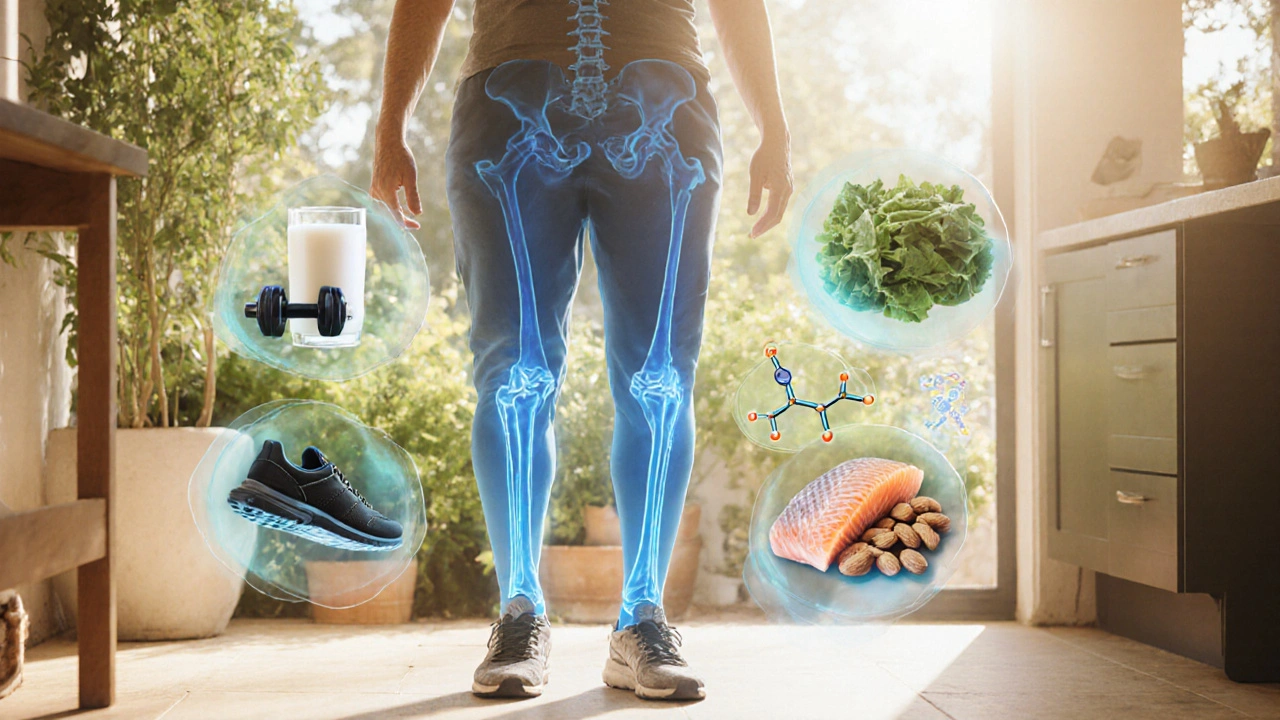

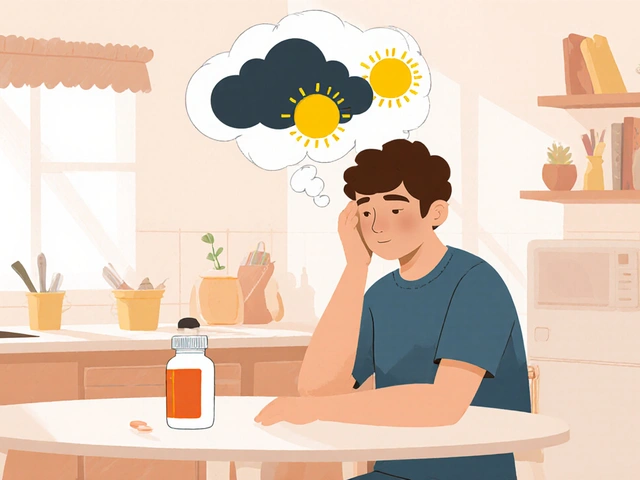
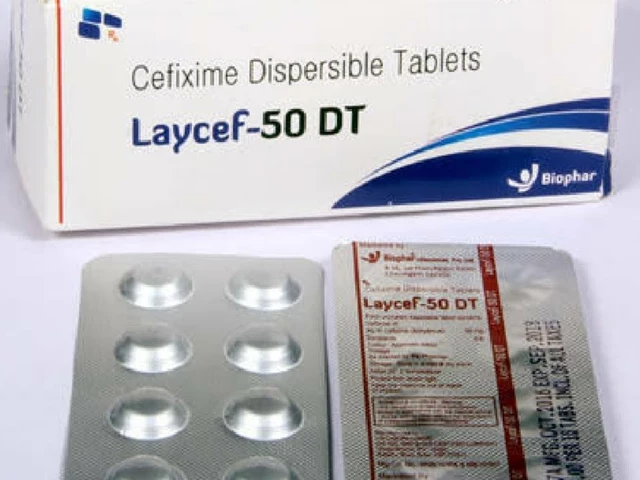
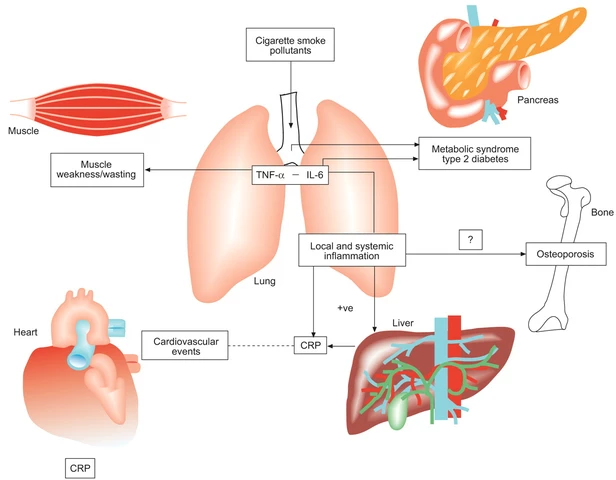
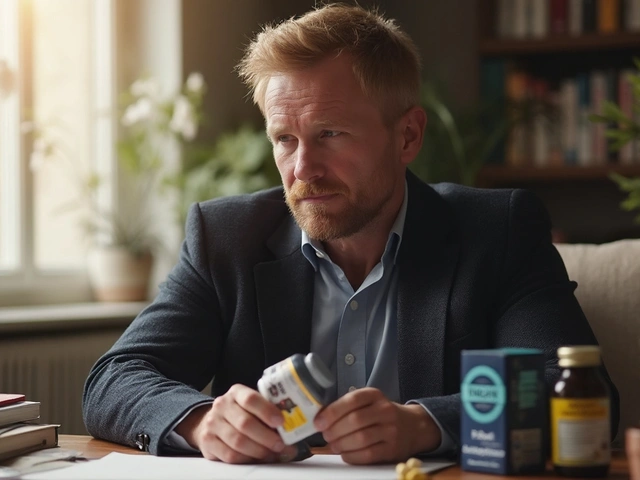
Liam Mahoney
October 4, 2025 AT 13:17Honestly, if you aren't already tracking your calcium and vitamin D like a health‑obsessed zealot, you're practically inviting bone decay. The holistic spiel sounds nice, but it's just an excuse for people to feel superior while ignoring basic diet basics. Stop pretending that a fancy calculator replaces real food decisions, and start eating dairy or leafy greens, definatly.
surender kumar
October 9, 2025 AT 04:24The truth is that most people will never stick to a 150‑minute weekly workout schedule, no matter how many shiny calculators you throw at them. And yet the narrative pushes the idea that just adding a pinch of magnesium will miraculously stop fractures. It’s a convenient story for those who love to sound virtuous while ignoring simple lifestyle inertia.
Justin Ornellas
October 13, 2025 AT 19:30From a mechanistic perspective, bone remodeling operates under the principles of homeostatic equilibrium: osteoclasts resorb, osteoblasts lay down matrix, and the net balance dictates mineral density. Therefore, any intervention-dietary, mechanical, or pharmacologic-must be evaluated against the differential equations governing calcium flux and hormonal modulation. Neglecting the role of vitamin K₂, for instance, introduces a systemic bias that skews the solution toward vascular calcification rather than skeletal fortification. In lay terms, you cannot expect optimal bone health without addressing every variable in the equation.
JOJO Yang
October 18, 2025 AT 10:37Listen, the moment you ignore the symphony of nutrients-calcium, vitamin D, magnesium, and that elusive K₂-you’re essentially yelling at a brick wall and expecting it to applaud. It’s not just a matter of “more dairy” or “hit the gym”; it’s an existential battle between decay and resiliance that unfolds silently in your marrow. Miss a dose, and you’re courting fragility with the same reckless abandon you reserve for a midnight binge.
Faith Leach
October 23, 2025 AT 01:44The pharmaceutical lobby doesn’t want you to know that the “bisphosphonate miracle” is a two‑front war: they market a drug that quietly erodes your jaw while they sell calcium supplements as a patriotic duty to keep the nation’s bones strong. Meanwhile, the real threat comes from hidden agenda labs pushing “synthetic” vitamin D that binds to receptors only to feed their profit pipelines. Wake up, protect your health, and don’t let foreign conglomerates dictate how you maintain your skeletal integrity.
Eric Appiah Tano
October 27, 2025 AT 16:50Great rundown! If you’re just starting out, focus on three practical steps: hit your daily calcium target with dairy or fortified alternatives, schedule a short walk or stair‑climb each day, and book a DXA scan before you turn 50. Small, consistent actions add up, and you’ll see measurable improvements without feeling overwhelmed.
Jonathan Lindsey
November 1, 2025 AT 07:57In the grand tapestry of human health, bone integrity occupies a singular yet profoundly impactful thread.
It is both a structural foundation and a silent sentinel, bearing the weight of our ambitions and quotidian motions.
Consequently, the proposition of a holistic approach is not merely advisable but, in my view, an ethical imperative.
One must first acknowledge the biochemical symphony wherein calcium, vitamin D, magnesium, and vitamin K₂ perform in concert.
Neglecting any component is tantamount to silencing a vital instrument, resulting in a discordant and fragile composition.
From a nutritional perspective, a daily calcium intake of 1,200 milligrams, ideally partitioned across meals, ensures optimal absorption.
Equally, maintaining serum vitamin D levels between 30 and 50 ng/mL facilitates the intestinal uptake of this mineral.
Magnesium, often the unsung hero, activates vitamin D and supports the crystallization of hydroxyapatite within the bone matrix.
Vitamin K₂, meanwhile, directs calcium to the skeleton while averting ectopic calcification in the vasculature.
The mechanical dimension, exercised through weight‑bearing and resistance training, stimulates osteoblastic activity via mechanotransduction.
A regimen encompassing at least 150 minutes of moderate aerobic activity complemented by two to three strength sessions per week yields measurable gains in bone mineral density.
Balance exercises, such as tai chi, further mitigate fall risk, thereby addressing the extrinsic factor of trauma.
Hormonal balance, particularly the replacement of estrogen in post‑menopausal women, modulates osteoclast inhibition and cannot be overlooked.
Routine monitoring, employing DXA scans and FRAX calculations, provides the empirical data needed to tailor interventions.
Pharmacologic agents, while efficacious, are most successful when paired with lifestyle modifications rather than deployed in isolation.
In sum, the integration of nutrition, physical activity, hormonal equilibrium, and vigilant assessment forms a comprehensive strategy that transcends the limitations of a singular therapeutic modality.
Embracing this paradigm not only fortifies the skeletal framework but also exemplifies a proactive stance toward holistic wellbeing.
Gary Giang
November 5, 2025 AT 23:04Think of your skeleton as a canvas; the right pigments-calcium, vitamin D, magnesium, K₂-bring vivid resilience to the picture. Adding a splash of weight‑bearing exercise is like the bold brushstrokes that give depth. Keep the palette balanced, and the masterpiece endures.
steve wowiling
November 10, 2025 AT 14:10Sure, that’s poetic, but unless you actually pick up a dumbbell or walk up stairs, your “canvas” stays blank. Lazy critique aside, action trumps metaphor every time.
Warren Workman
November 15, 2025 AT 05:17While the mechanistic model you outlined holds theoretical merit, it neglects the emergent properties of osteo‑immunology, a critical axis that modulates remodeling via cytokine cascades. Ignoring this variable introduces a systemic error in the predictive algorithm.